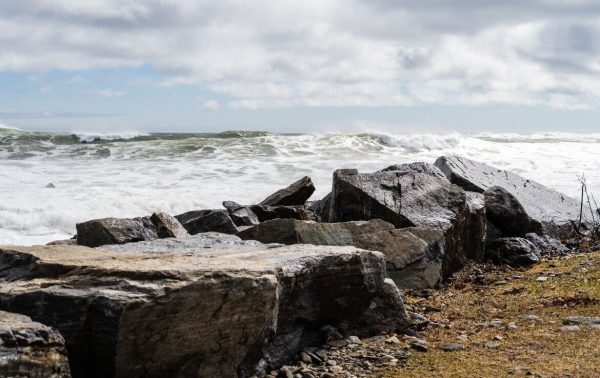When you think of New Hampshire’s 18 miles of coastline, notably the shortest coastline in the U.S., you may think of beautiful ocean vistas at every twist and turn, a scene encapsulated by a range of deep blue hues of the Atlantic Ocean. You may think of Route 1A which winds through New Hampshire’s most popular beaches: Hampton Beach, Jenness Beach and Wallis Sands Beach, to name a few. You may think of delicious locally-made ice cream, yummy food and fun summer attractions, all a part of a greater critical tourist economy that brought in almost $2B to New Hampshire in 2021. However, these iconic New Hampshire features are at risk in the face of climate change. Increased precipitation is a main concern, which is shown in data from the 2021 New Hampshire Climate Assessment.
University of New Hampshire (UNH) climate researchers have been working on infrastructure projects, as well as climatologist reports to assess the landscape of changing weather patterns, and also adapt solutions for the changing environment.
“The effects of increases in total annual precipitation and a more than 50% increase in extreme precipitation from 1996-2016 compared to 1901-1995, most [of] which occurred during summer and fall, include increasing flood frequency,” according to the 2021 New Hampshire Climate Assessment.
Researched and written by UNH climate researchers Mary Stampone, Cameron Wake and Elizabeth Burakowski, the aim of the climate assessment is to share “recent research focused on the U.S. Northeast provides detailed insights and impacts of our warming climate, now and in the future.”
The impact of a “50% increase in extreme precipitation” is that “without significant reductions in atmospheric greenhouse gasses (GHG), extreme precipitation events are projected to increase a minimum of 20%, leading to an increase in freshwater flooding regionally. Flood risk in New Hampshire’s coastal watershed will continue to increase due to rising seas and more extreme precipitation events,” said the 2021 New Hampshire Climate Assessment.
These weather changes “are likely to have negative consequences on northern forest ecosystems, impacting valuable rural industries, including logging and outdoor recreation.”
“Hampton is a really busy place [and] relies a lot on tourism. It brings in a lot of money to the state, generally, too. So it’s not just a local issue, but it’s also a state issue. And so having roads closed, due to either flooding or for long, long or extended periods of time, from flood damages during a storm, like we saw over the winter, that has really important implications for the state’s economy,” said Mary Stampone, New Hampshire state climatologist and UNH researcher & professor.
Much of Stampone’s work revolves around studying anthropogenic climate change, that is, human-induced climate change. As the New Hampshire State Climatologist, “she provides New Hampshire citizens, educators, and agencies with weather and climate information in support of environmental management and planning activities,” according to her about page on UNH’s College of Engineering and Physical Sciences (CEPS) website.
Stampone described “nuisance” flooding which has become more prevalent.
Nuisance flooding is “the high tide flooding. It’s when you get actual inundation of the community that’s kind of beyond the beach and the dunes when that floods during a regular high tide,” said Stampone.
She elaborated that once a month there will be an extra high tide because of the phases of the moon that raise and lower the tides. This monthly extra high tide creates a further risk for coastal flooding.
“And so with sea level rise, kind of moving that whole interface further inland, some of these high tides are actually starting to flood the boardwalk and have Hampton [flood] or flood some of the properties that are just like on the other side of the beach and in a really bad high tide, they can’t even get to Route 1A,” said Stampone.

Jo Sias, a civil and environmental engineering professor at UNH, started work related to researching more resilient infrastructure to be implemented in New Hampshire that would be less apt to deteriorate during tidal flooding. Sias’s work on this project began with the New Hampshire Sea Grant.
“In that project, what we did was build a framework for evaluating different adaptation alternatives for pavements, subjected to sea level rise and changing climate,” said Sias.
Sias said that a major facet she’s studied around tidal flooding is the groundwater table. The groundwater table is how much water is stored in the ground, and how when water has nowhere to go but up is what happens when big tidal floods occur. When the water pushes up through the ground, it adds to the flooding already created by tidal flooding from the ocean, creating more damage.
Through that project, she and her team looked at New Hampshire roadways to assess which roads might be vulnerable when the groundwater table rises.
They’re “looking at coastal roadways, and developing a toolkit on how to evaluate different adaptation alternatives. Just strictly looking at coastal roadways, and looking at both, you know, traditional engineering hard infrastructure approaches, as well as nature-based solutions. So that’s part of an ongoing project; we’re about two and a half years in the four-year project,” said Sias, who is working on a development project with the National Oceanic and Atmospheric Administration (NOAA).
Nature-based solutions to help mitigate the deterioration of roadways include marsh restoration, Sias said. There are current projects, such as Gregg Moore, professor of biological sciences at UNH, working toward implementing stronger sediments in New Hampshire marshes to research and test which sediments can absorb the most water. Marshes can act as a key barrier against tidal flooding, soaking up high and king tides.
New Hampshire’s coastline is a defining area of the state that many people hold near and dear to their hearts. With the coast at risk of increased tidal flooding, leading to road closures, mass flooding and damage to infrastructure, these 18 miles of coastline are in danger of being unable to hold the threshold of people it does now. With the work of UNH climate researchers, UNH is taking strides to create adaptation solutions in the face of climate change and work to preserve the Granite State’s Seacoast.






















